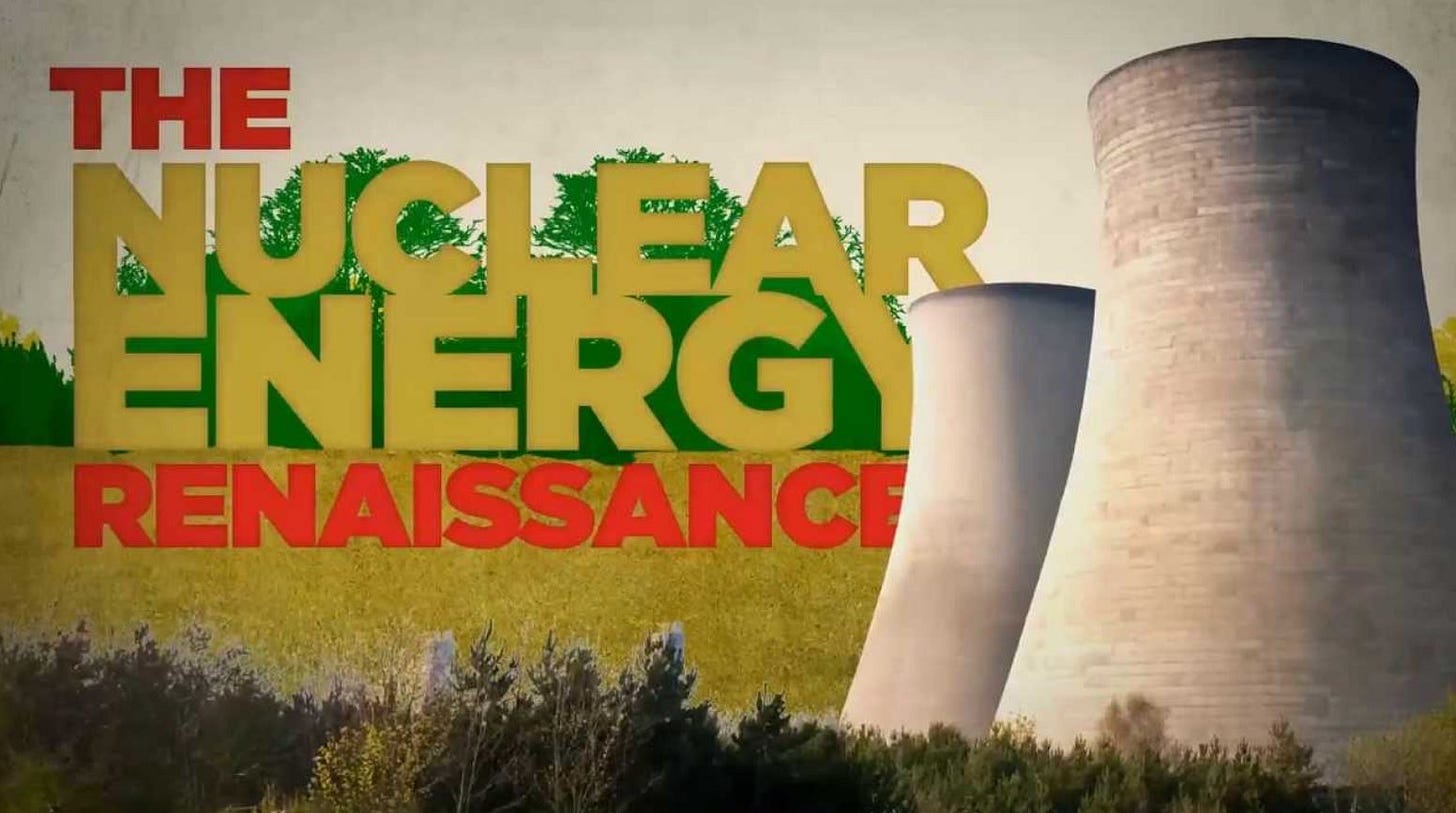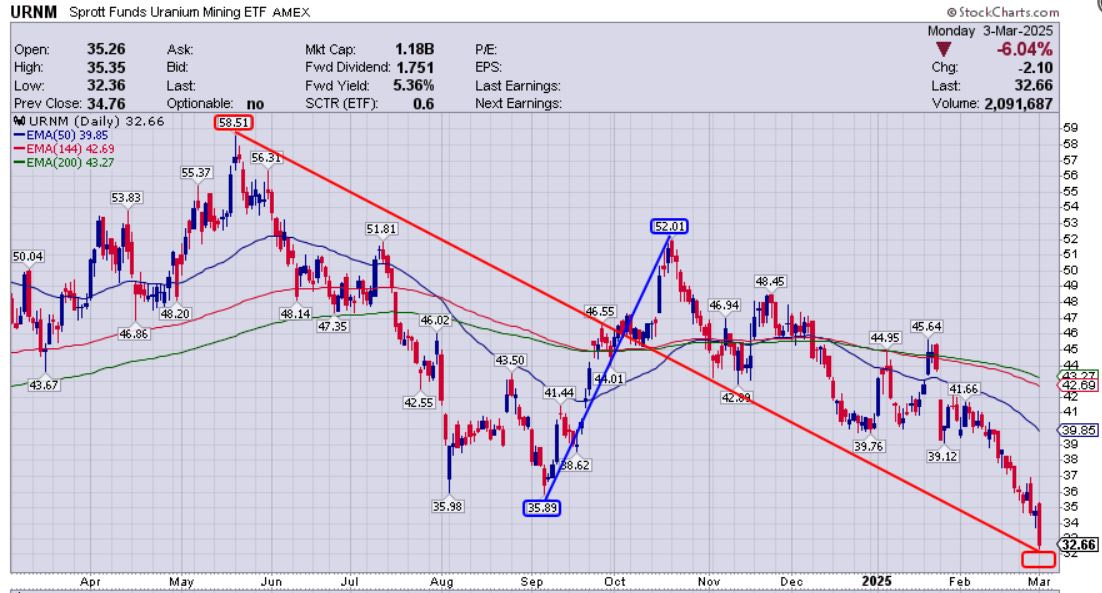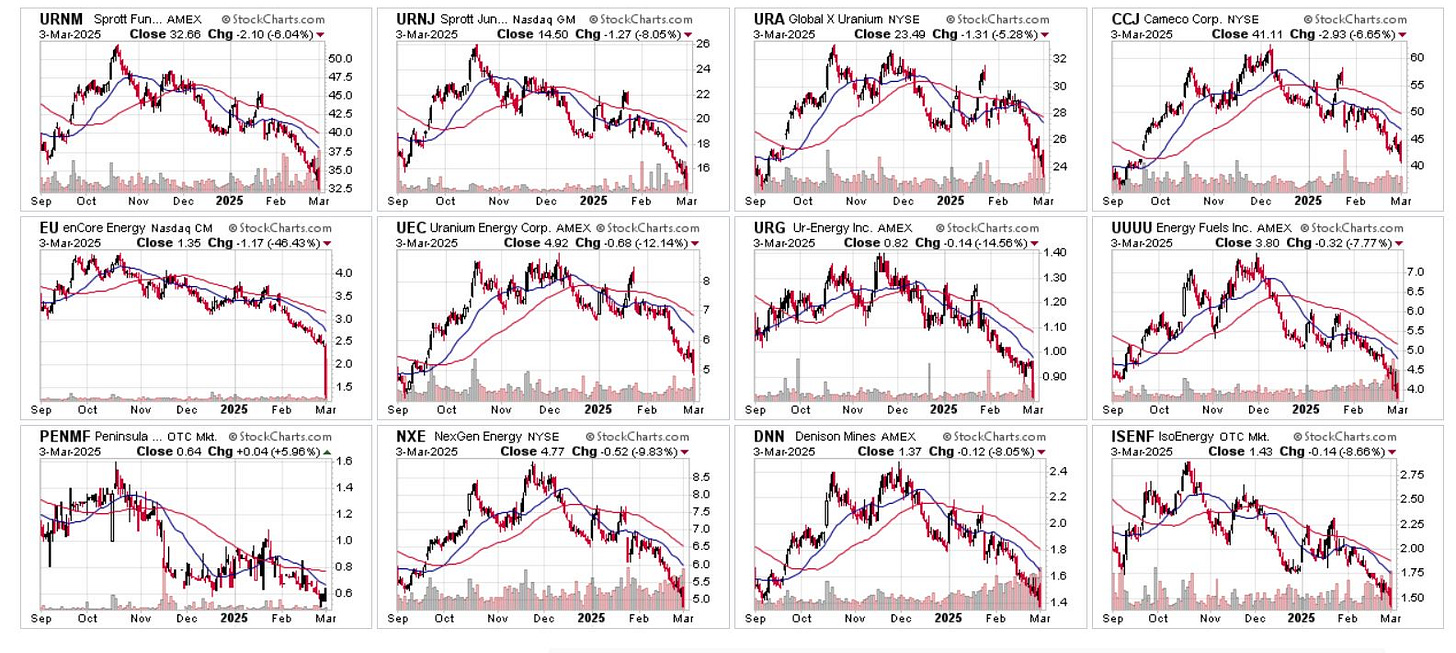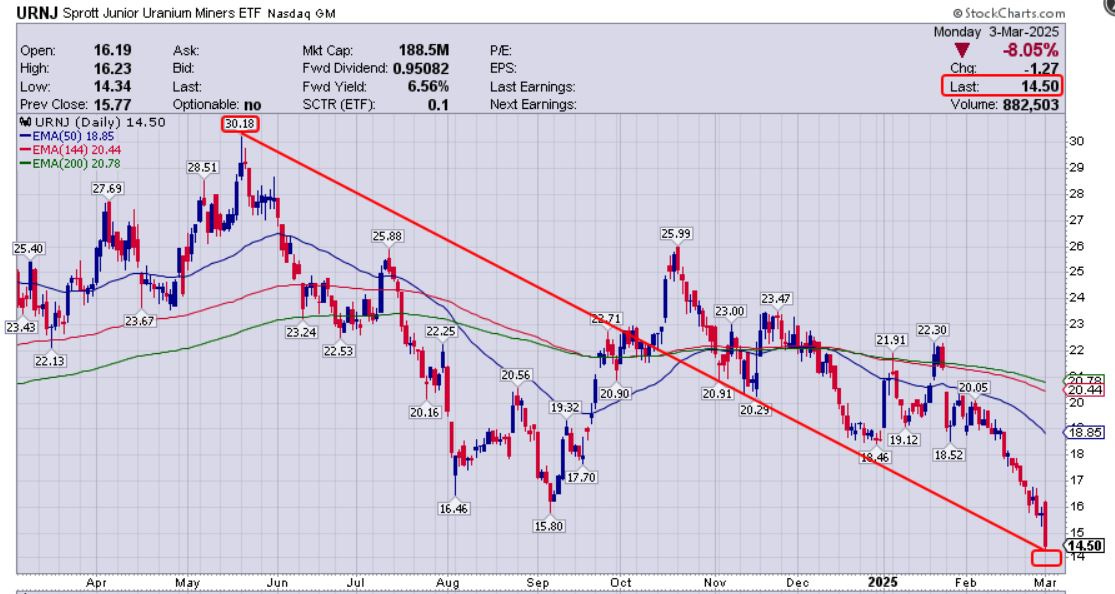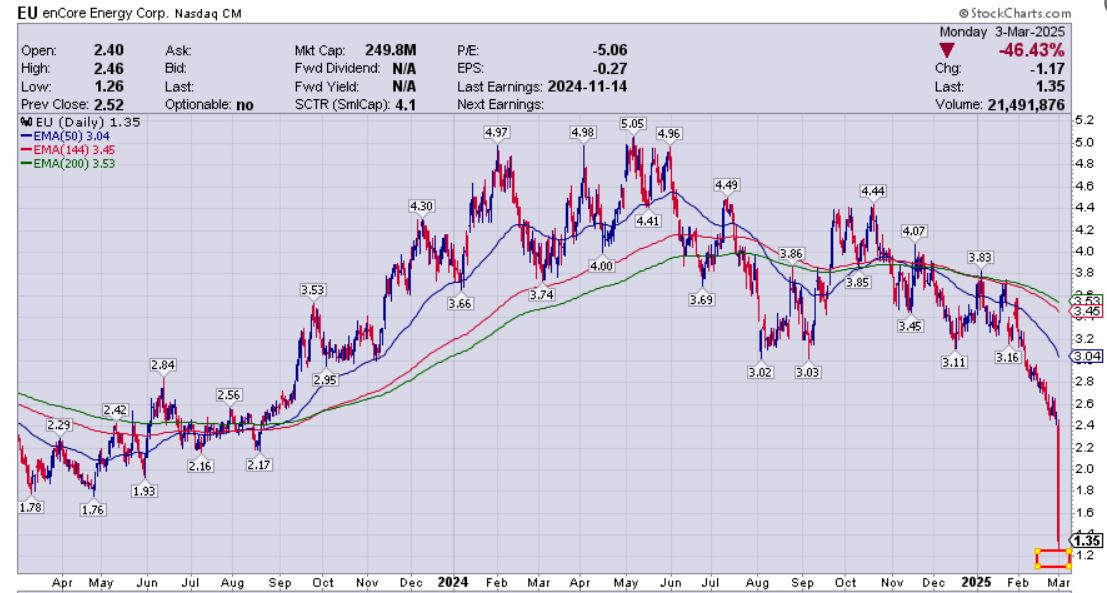Did The Nuclear Renaissance Just Get Canceled?
Excelsior Prosperity w/ Shad Marquitz (03-03-2025)
Did the nuclear renaissance just get canceled? (not likely)
Consider that there are still about 60 reactors either under construction or planned, and over 120 reactors proposed globally. In addition to that, there have been continued announcements the last few years of both mine restarts and reactor life extensions. This demand swell is happening in a backdrop where there is already an ongoing annual supply deficit in uranium production every year. The secondary supplies from underfeeding from centrifuges in the East and the downgrading of weapons grade nuclear weapons has largely been mopped up over the prior decade.
Additionally, AI data centers, and other big-tech buildouts are seeing the advantages mount for generating carbon-free 24/7 baseload electricity through nuclear power as part of their more broad initiatives. While this may take longer to play out than initially envisioned, all that growth is still there as a further demand driver on the future horizon.
Reflecting on economics 101: What does it mean if the demand is growing for more nuclear fuels, and yet there is a shortfall in new supply?
There is still a very critical tipping point coming with regards to where all the uranium will come from just from the current nuclear power demand requirements. Uranium is the feed source to the nuclear fuel process for both the current reactor demand, as well as the future reactor growth demand. This presents a true opportunity for the uranium companies that either grow production or go into production over the next several years. It also presents a legitimate investment opportunity for those savvy enough to connect the future dots in this sector.
There are also related ripple effects that are being experienced across the sector. With regards to processing uranium into UF6 and then Low-Enriched Uranium (LEU) as nuclear reactor fuels, there are serious current bottlenecks in this market due to the western sanctions on Russian supplies, and Russia’s export ban to the US of this crucial nuclear fuel. There are few domestic solutions in the West, with regards to nuclear fuel processing and enriching, and so again this presents an opportunity to investors willing get positioned in a longer-term theme.
Having said all of that, today was still a really ugly day in the nuclear stocks and uranium equities.
Uranium mining companies, uranium enrichers and nuclear fuel stocks, and small modular reactor stocks, were all down significantly today. Upon zooming out, really this whole sector has been under pressure for a number of months. This isn’t just a one day strong move down… this corrective wave has had legs.
Many investors have finally capitulated in this latest downturn, and are labeling this sector as “dead money,” and rightly so… One can understand the frustration of investors as it has been an overall downwards corrective trend for the uranium equities for many months now, as evidenced by the URNM chart below:
URNM is down 44% from its peak last May at $58.51, down to today’s close at $32.66.
URNM had a nice counter-trend rally from that September low of $35.89 up to the October peak at $52.01, but that move happened in just over a month’s time. Investors would need to have been buying that double-bottom dip to capitalize on that brief pop.
The way URNM pricing closed here on March 3rd is substantially below all key moving averages (the 200-day, 144-day, and 50-day Exponential Moving Averages). Additionally, this uranium equities ETF made a new “lower low”; below the prior double-bottom trough levels of $35.98 in August and $35.89 in September. This is all very bearish action but has been going on for some time now, and the cure for low prices will be low prices…
Uranium spot pricing has continued to weaken. Even though the spot price only accounts for small one-off transactions, and is not nearly as important as the larger pounds contracted for longer-term offtake pricing agreements; it still has a dramatic effect on investor sentiment and how they trade the equities.
Other than brief rallies, uranium equities have been a losing sector over the last 9 months. This interests the contrarian investor in me that likes to buy into weakness when prices are actually “low.” [As a reminder for folks reading this that just can’t get past how ugly the price action has been in the uranium equities — it never feels good emotionally or with regards to sentiment to buy any sector or equities when prices are legitimately low and undervalued.]
The issue here is looking for how much lower they will go, when there will be selling exhaustion and capitulation, and then watching for where pricing will base before the next rally. Nobody knows the answer to that question, but we can know that the pricing in longer-term off-take contracts that uranium companies have been signing and that they are willing to sign is substantially higher than the current spot pricing. If all the aforementioned supply/demand fundamentals are true for the growing nuclear power sector, then risk to reward valuations are actually getting more attractive (not less so) for investors that can see where this is all heading.
Nuclear stocks were still holding up better than uranium equities, and were continuing to run through the end of last year and into January. Then when the sailing seemed smoothest, they were torpedoed with the January 27th news regarding the Chinese AI platform DeepSeek.
Nvidia Stock Sinks in AI Rout Sparked by China's DeepSeek
Wall Street Journal - Jan. 27, 2025
“Technology stocks tumbled Monday on news that China’s DeepSeek had trained a sophisticated artificial-intelligence model at a fraction of the cost of its Silicon Valley rivals, triggering a sudden reversal of the recent AI rally.”
https://www.wsj.com/livecoverage/stock-market-today-dow-sp500-nasdaq-live-01-27-2025
This potentially less expensive option for AI development threw a metaphorical wrench into the gears of the domestic AI datacenter dreams. This news simultaneously dampened the envisioned demand for their electricity requirements, which strongly favored more traditional nuclear power development as well as small modular reactors. On the technical side, pricing closings in many sector equities have not been able to punch back above key resistance levels, and momentum has been continuing to build to the downside.
So, let’s heed the mantra “bring out your dead,” from trading on Monday March 3rd in the nuclear stocks and uranium equities; and let’s see where the bodies are buried.
Nuclear Fuels and Nuclear Power companies were hit in today’s selloff:
The largest domestic publicly traded nuclear fuel enricher Centrus Energy Corp. (NYSE American: LEU) was down -7.4% today.
Nuclear fuel fabricator Lightbridge Corporation (Nasdaq: LTBR) was down -11.8%
Nuclear fuels and nuclear reactor components company BWX Technologies, Inc. (NYSE: BWXT) fared the best today only down -2.4%
One of the largest US utilities heavily exposed to nuclear power, Constellation (NASDAQ: CEG) was down -7.3% today.
Small Modular Reactor stocks got rocked to the downside today:
NuScale Power Corporation (NYSE: SMR) – closed down -10% today
Nano Nuclear Energy Inc (NYSE: NNE) – closed down -5.5% today
Oklo Inc (NYSE: OKLO) – closed down -12% today
The uranium mining ETFs were under pressure today:
Sprott Uranium Miners ETF (NYSE: URNM) – closed down -6%
Sprott Junior Uranium Miners ETF (Nasdaq: URNJ) – closed down -8%
Global X Uranium ETF (NYSE: URA) – closed down a mere -5.3%
The only royalty company in the uranium sector, Uranium Royalty Corp. (NASDAQ: UROY) was down -12%
The largest North American uranium producer, and sector bellwether, Cameco Corp (NYSE: CCJ) - closed down -6.7%
The US uranium producers also got hit today:
Uranium Energy Corp (NYSE American: UEC) – closed down -12%
Energy Fuels Inc (NYSE American: UUUU) – closed down -8%
Ur-Energy Inc. (NYSE American: URG) – closed down -14%
Peninsula Energy Limited (OTCQB: PENMF) – closed down -9%
However, the US uranium producer stock that was down today the most was enCore Energy Corp. (NASDAQ: EU) – plummeting down to around -46% at one point in afterhours trading. There were fundamental news factors at play today in this stock, on top of the sea of red across the sector. More on that later on…
The larger uranium developers were also slammed down today:
NexGen Energy Ltd. (NYSE: NXE) – closed down -9.8%
Denison Mines Corp. (NYSE American: DNN) – closed down -8%
IsoEnergy Ltd. (OTCQX: ISENF) – closed down -10%
This was just ugly action sector-wide today, but one day doesn’t make a market. What is more concerning to many investors that track this sector, is that it was an acceleration move of a longer correction that has been playing out in the sector for many months now. The commodities sector is notoriously volatile and the uranium space especially so.
Because this sector can oscillate wildly from bull to bear and back to bull, it is important to make this volatility one’s friend and capitalize on buying into the dips, and then selling into the rips. Eventually either selling or buying becomes exhausted, and those are the inflection points to add to or trim back positions respectively.
So, while nobody knows when this recent corrective move in the uranium stocks will find a bottom, we can surely say that it is much closer to that bottom after today’s trading than it was back at the prior peaks in May of last year. If investors thought the longer-term value was present in the bull case for nuclear power and uranium mining last year, at much higher valuations, then while it is painful to see, this current price weakness is actually a much better risk/reward arbitrage for accumulating value at a discount.
The URNJ share price has been more than chopped in half since late last Spring. So, we can clearly see that the collection of junior uranium stocks inside of this ETF have been under pressure as a group. One way of looking at this is that they are also presenting a half-off sale on the clearance rack. Some of the downward pressure in these stocks is warranted, because there has been a corresponding corrective move in the uranium pricing. However, as already discussed above, that condition is unlikely to persist in the medium to longer-term.
Today’s trading action really stung personally, because enCore Energy (EU) is the second heaviest weighted uranium stock in my portfolio. I also have positions in Energy Fuels, Uranium Energy Corp, Ur-Energy, Peninsula Energy, Dension Mines, and NexGen Energy mentioned up above. I want to focus in on what happened in enCore Energy though, because they put out some news today that further roiled this stock.
enCore Energy Corp. Reports Fiscal Year 2024 Financial Results and Files Annual Report on Form 10-K - March 3, 2025
“As of January 1, 2025, the Company’s reporting status with the SEC changed from a foreign private issuer to a U.S. domestic issuer. As a result, the Company transitioned from International Financial Reporting Standards ("IFRS") to U.S. Generally Accepted Accounting Principles ("U.S. GAAP") for all its financial reporting requirements.”
OK, so they are now switching their accounting method to the US GAAP requirements, but some investors didn’t factor in how that was affecting their net loss. Here is a passage from the above press release that breaks this point down:
“The Company reported a net loss of $61.3 million for the year ended December 31, 2024, compared to a $25.6 million net loss for the year ended December 31, 2023. The inability to capitalize certain exploratory and development costs under U.S. GAAP which would have been capitalized under IFRS impacted both years, totaling $15 million for 2024, and $8 million for 2023.”
So that is an ugly net loss, any way one slices it, at $61.3 million for 2024. However, if $15 million was shaved off then it would have been a little less ugly at a $46.3 million. This change in accounting method was not fully grasped by the market.
“enCore reported total revenue of $58 million, reflecting a 163 percent increase from the year ended December 31, 2023, primarily due to increased uranium extraction… enCore ended the year with $39.7 million in cash and cash equivalents.”
It wasn’t all bad news financially, but these positive points were overshadowed.
“In 2024, enCore completed eight uranium sales to third parties totaling 720,000 pounds U3O8 at an average sales price of $81.02 per pound U3O8, not including converter and transaction costs… The Company has executed twelve uranium sales agreements to supply uranium to nuclear power plants in the United States and one legacy uranium sales agreement with a uranium trading company. These agreements represent various delivery periods from 2024 through 2034. enCore’s uranium sales agreement portfolio is a mix of market related pricing, hybrid base price and market related pricing, base escalated pricing, and fixed prices.”
From a sales perspective, things appear to be going well for enCore, and personally I like the mix of pricing terms on those various contracts, locking in more fixed pricing on some and then escalating flexible market pricing with others to catch optionality in potential pricing improvements over the next decade.
“enCore is focused on installing wellfield patterns to expand uranium extraction in South Texas. Since the start of 2024, the Company has increased the number of drilling rigs to 17 operating in South Texas. The increased drilling rig count will alleviate bottlenecks in wellfield pattern replacement rates observed earlier in the year that delayed expansion of uranium extraction. The Upper Spring Creek Project will provide uranium-bearing resin to the Rosita CPP following final permitting expected to be complete in 2025.”
This portion of the news describes the company having a plan to expand production and reduce bottlenecks. Once permits are received they will also be able to grow production at Rosita. These are reasons to believe that the balance of 2025 is on track to go better than in 2024. So again, if investors liked the value proposition in enCore Energy last year at their operations, then they’ve only become more attractive for the year to come as the valuation has pulled down lower.
“On March 2, 2025, the board of directors of enCore appointed Robert Willette, the current Chief Legal Officer, as Acting Chief Executive Officer, effectively immediately. Mr. Willette succeeds Paul Goranson, who is no longer serving as enCore’s Chief Executive Officer or as a member of the board of directors.”
This news of Paul no longer being the CEO really shocked and surprised the market today. This was only mentioned briefly further down the press release, but was not lost in the hustle and bustle of uranium pain and reasons to sell U-stocks today. People jumped to the conclusion that there were problems in paradise, and maybe there were personality clashes or differences in vision of how to proceed between the board and CEO. Those things happen in many public companies, and they typically get resolved if the board is competent; which I believe is the case with the team behind enCore Energy.
Personally, I have a great deal of confidence here with Willam (Bill) Sherriff at the helm as the Executive Chairman. I’ve now met with him face to face several times at resource conventions, as well as hosting him on our KE Report show for interviews. Bill is a class-act, a straight-shooter, candid, and brutally honest.
My perspective is that the extreme selling got way overdone today, where at one point EU was down over 46%. This degree of selling is illogical, but as the old saying goes: “The markets can stay irrational longer than you can stay solvent.”
If I consider whether this news warranted the value of enCore Energy to essentially get chopped in half today, then again, that selling seems really overdone. As a result, I added another tranche at $1.39 to my portfolio position into this weakness. My perspective is that a leading US uranium producer just presented me the opportunity to pick up more shares on the cheap.
{This is not investment advice, and I’m well aware that this stock could just keep dropping into the market F.U.D. (Fear, Uncertainty, and Doubt). It is a risk that I’m comfortable taking personally. If EU sells off even more, barring any other fundamental issues with the company, then I’ll likely keep adding to this position at even lower levels for capitalizing on the longer-term thesis.}
That’s all I have to say at this point in time on this stock and the uranium and nuclear sector overall. This seemed like significant enough pricing action today, to give readers here an update on what happened, while trying to put it in the context of the larger megatrend that is unfolding.
Thanks for reading and may you have prosperity in your trading and in life!
• Shad



